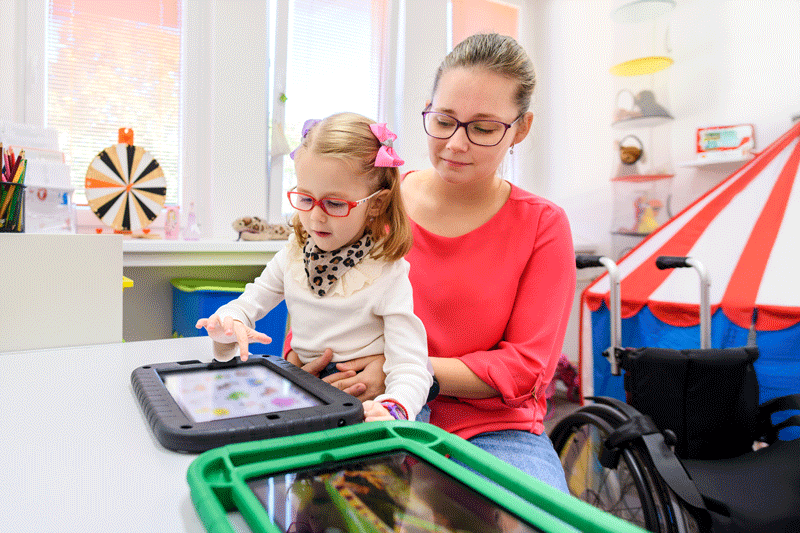Clear and effective communication is one of the most significant challenges autistic individuals encounter. As with many other characteristics of autism, the communication abilities of autistic individuals present across a wide spectrum. While many individuals understand and use spoken language, they may encounter difficulties using language effectively in certain situations, particularly social situations. For others, the comprehension and use of spoken words may be significantly impacted by autism. Nearly 30 % of autistic individuals will not develop spoken words or will develop only a small vocabulary of expressive words that are not sufficient to meet their communication needs (Holland, 2023). To enable individuals who are considered to be minimally verbal or nonverbal learners with a communication modality other than speech, an augmentative or alternative communication system (AAC system) is typically introduced.

AAC refers to an area of clinical practice that supplements or compensates for impairments in speech-language production and/or comprehension and falls under the broader umbrella of assistive technology or the use of any equipment, tools, or strategies to improve functional daily living in individuals with disabilities or limitations (American Speech Language Hearing Association, n.d.). These supplemental systems can include unaided systems, such as sign language or gestures, in which no external tools are needed, or aided systems in which external tools or materials are used. Aided systems range from light tech systems, which may use printed picture symbols or objects, to mid-tech systems, which can include switches or simple voice output systems, to high-tech voice output devices such as tablets. These systems are considered augmentative when used to supplement existing speech or alternative when used in place of speech that is absent or non-functional (Elsahar et al., 2019).
For non-verbal and minimally verbal autistic individuals, establishing an effective functional communication system should be an immediate priority in improving outcomes. Often, challenging behaviors arise in autistic individuals in the absence of an effective communication system. Learning to communicate in an effective way can be life-changing for these individuals and their families.
Assessment is the fundamental first step in understanding the individual’s communication abilities and needs. A thorough AAC assessment serves as a guide for choosing the best system; however, there is currently no prescriptive assessment available that can specifically define the best match between an AAC system and the individual user. According to Ganz (2014), “Given the variability in both the type of AAC interventions as well as the heterogeneity of skills and characteristics among individuals with ASD, it is difficult to establish that a particular type of AAC system will be effective for a given individual.” With this understanding, systems are proposed based on a feature-matching analysis in which the individual’s skills and needs are matched to the capabilities of the proposed systems. The SETT (Student Environments Tasks Tools) Framework is a model frequently used to assist teams in this decision-making process (SETT- Joy Zabala Site, n.d.). Trials are then conducted to gather objective data about the individual’s response to the proposed systems, and the most effective system is ultimately selected for the individual. The assessment process should not stop here, however. A system that was deemed to be a good fit for an individual during the initial evaluation process may not continue to be optimal if the individual progresses rapidly and his or her communication needs expand. Conversely, some individuals continue to use a selected system for long periods of time in the absence of real progress with no adaptions to instruction. Attention to ongoing assessment and decision-making is needed to ensure that an individual’s communication system is as effective as possible. The following parameters are essential for our teams to evaluate when determining if an individual with no or limited verbal abilities is using his or her communication system effectively. We have focused our examples on alternative communication systems. However, these parameters can be applied to individuals who use spoken language to varying degrees as well.
- Independence – The individual is able to use his or her communication system on his or her own, needing prompting or assistance only occasionally. An independent communicator can access his or her device, navigate to desired icons, and construct and deliver a message from start to finish without assistance. If the communication partner must regularly gesture to the device, gesture to icons, or model responses in order for the individual to deliver the message, the individual is demonstrating difficulties communicating independently.
- Initiation – The individual is typically able to spontaneously construct and deliver a message without prompting, questions, or other assistance. For example, an individual with solid initiation skills will gain the attention of a communication partner and activate a ‘help’ button on his or her device upon encountering difficulty. If the struggling individual activates the ‘help’ button only after a communication partner asks, “What do you need?” this individual is showing a deficit in initiation.
- Accuracy – the individual demonstrates an understanding of the communication system’s picture symbols or manual signs. An individual demonstrating accurate communication uses signs or symbols appropriate to the situation, or that match the desired item he or she is motivated to access. Individuals who ‘scroll’ through signs or immediately activate a certain icon on their devices, regardless of the context, may be having difficulty understanding the meaning of the symbols in their current system.
- Intelligibility – the individual is able to deliver a message that can be easily understood by a wide range of others across multiple settings. For example, a vocabulary of highly personalized manual signs might be understood only by familiar communication partners, not by the larger community. A voice output system might require multiple language capabilities for bilingual families.
- Specificity – the individual is able to deliver a message with necessary detail. That is, the individual can use the system to construct a request that communicates his or her specific preferences, such as requesting ‘chocolate milk’ or ‘apple juice’ rather than (or in addition to) a general request for ‘drink.’
- Range – the individual is able to use the system for multiple communicative Diverse communicative range can include the ability to request desired items or activities, indicate needs such as ‘bathroom ‘or ‘help,’ share information of personal importance, accept or reject items, and so on.
- Efficiency – from the moment an individual begins to construct a message, it takes no longer than 5-6 seconds to deliver.
- Generalized – the individual is able to use his or her communication system consistently across different settings, including home, school, work, and community, with different communication partners and in different situations.
In many cases, a combination of modalities may comprise an individual’s communication system. A single individual may verbalize ‘yes’ and ‘no,’ wave in response to greetings, and use a voice output system to make specific requests. The parameters described above can be used to guide teams in evaluating an individual’s strengths and needs with regard to the effectiveness of his or her current communication system. If data indicates significant deficits in any of the above parameters, the team should discuss adaptations to current instruction or possibly consider another approach to intervention.
It is important to remember that an AAC user’s communication needs can and will change over time as he or she develops new skills and encounters new challenges. Many individuals begin by using a less complex system as they develop foundational communication skills such as initiation, social approach, and understanding of picture symbols. Later, they may advance to more complex systems if the components of that system better meet their current communication needs. Some individuals may require the addition of AAC supports for a period of time in new or unfamiliar situations, and some individuals may gradually rely less on an AAC system if spoken language begins to emerge and becomes consistent. Whatever an autistic individual’s communication system may include, attention to ongoing assessment is critical to ensuring the most effective communication possible.
Maryanne Robertson, MS, CCC-SLP, is Private Practitioner and Consultant at Speech Paths, LLC. Dr. Todd Harris, PhD, is Executive Director of Autism Services at Devereux Advanced Behavioral Health. Questions or requests related to this article can be sent to Maryanne Robertson at maryanne@speechpaths.org.
References
American Speech-Language-Hearing Association. (n.d.). Augmentative and Alternative Communication (AAC). https://www.asha.org/practice-portal/professional-issues/augmentative-and-alternative-communication/#collapse_3
Elsahar, Y., Hu, S., Bouazza-Marouf, K., Kerr, D., & Mansor, A. (2019). Augmentative and alternative communication (AAC) advances: A review of configurations for individuals with a speech disability. Sensors, 19(8), 1911. https://doi.org/10.3390/s19081911
Ganz, J. B., Mason, R. A., Goodwyn, F. D., Boles, M. B., Heath, A. K., & Davis, J. L. (2014). Interaction of Participant Characteristics and Type of AAC with Individuals with ASD: A Meta-Analysis. American Journal on Intellectual and Developmental Disabilities, 119(6), 516–535. https://doi.org/10.1352/1944-7558-119.6.516
Holland, K. (2023, December 15). Understanding nonspeaking autism. Healthline. https://www.healthline.com/health/autism/nonverbal-autism#:~:text=Some%20autistic%20people%20may%20not,it%20described%20as%20nonverbal%20autism
SETT | Joy Zabala Site. (n.d.). Joy Zabala Site. https://www.joyzabala.com/links-resources







